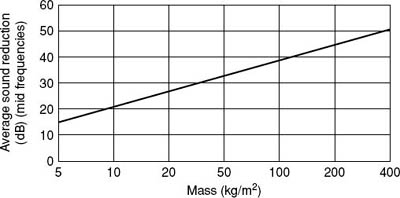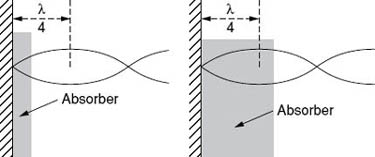3 Basic acoustics
Part 2
Sound isolation
It was stated in the first part of this chapter that the heavier a wall is the better it is at preventing airborne sound from travelling through it. Strictly we should talk not about the weight, but the mass/unit area, using units such as kg/m2 – in other words the mass of a square metre of the wall's surface.
The graph in Figure 3.5, known as The Mass Law, shows the approximate relationship between reduction in sound transmission and mass/unit area of the wall. This is only an approximate relationship as there are various lightweight structures consisting of two or more leaves of material which combine to give far better sound isolation than the combined weight (mass) of the leaves would suggest.
Sound absorption
As a general rule, any porous material can provide some sound absorption and it follows that, for example, gloss painting an otherwise porous surface will immediately reduce its absorptive abilities. Also, a single material will be an effective absorber only if it is thicker than about one quarter of a wavelength (see Figure 3.6). Thus, to absorb sounds of frequencies 300 Hz and above, when the longest wavelength is about 1 m, the absorbent material should be about 25 cm thick. In practice, there is some latitude in this and, for instance, curtains draped in 10-cm-deep folds may be found to be helpful. The same fabric, stretched, will be much less effective. It should be added that there are various types of wide-band porous absorber, consisting of more complex structures but capable of absorbing sound over a wide range of frequencies and at the same time not being unacceptably deep. The interested reader can find out more from some of the books listed under ‘Further reading’.

Figure 3.6 The operation of a porous absorber
The curves show the displacement of the air particles and not pressure. This is done to make the point that there is maximum particle movement at a quarter of a wavelength (λ/4) from the wall. Greatest frictional effects will therefore occur when this maximum movement is inside an absorber.
The effectiveness of a porous absorber can be increased if it is spaced from the wall by an amount equal to its thickness. Figure 3.7 illustrates this.
A useful indication of the sound-absorbent properties of a material is the sound absorption coefficient, often denoted by the Greek letter α (alpha). This is a number less than 1 and is a measure of the amount of the incident sound which is absorbed by the material. Thus, if α = 0 there is no absorption and all incident sound is reflected (or diffracted), depending on the size of the material. Similarly, if (α = 1 there is total absorption. Sometimes α is quoted as a percentage, e.g. α = 72% is equivalent to α = 0.72.

Figure 3.7 The effect of an airspace
Table 3.1 Some absorption coefficients
Material |
α (average) |
Plain brickwork |
0.04 |
Rough concrete |
0.05 |
13 mm building board |
0.2 |
Wood (typical) |
0.1 |
Curtains, velour, draped |
0.6 |
Curtains, sailcloth, draped |
0.16 |
Wilton carpet with underfelt |
0.6 |
Table 3.1 gives a few typical values of α. Note that with most materials α depends on the frequency of the sound, usually increasing with frequency. In Table 3.1, the absorption coefficient is given for a frequency in the middle of the range – about 400 Hz is often used as a convenient mid-range frequency.
It is a common misconception that polystyrene ceiling tiles are useful acoustic devices. This is not the case. They are too light in weight to provide any sound isolation and they are generally not porous enough or thick enough to provide significant absorption.
Unit of sound absorption
The basic unit of sound absorption is one square metre of 100% absorber. The name given to this unit is the sabine, after W. C. Sabine, the American physicist who did pioneering work in acoustics at the end of the nineteenth century. It was he who first introduced the concept of reverberation time and went on to realize that it depended on the volume of the room and the absorption in it. He did this without the aid of any modern electronics, training himself and his assistants to time the decay of a sound by ear. This was before decibels were thought of and Sabine used the time for a sound to decay to one millionth of its original intensity. (A ratio of a million to one corresponds to 60 dB!) For a sound source he had an organ pipe driven by air at a constant pressure.
1 sabine = 1 m2 of material for which α is 1.0
The number of sabines provided by a surface can be found by multiplying the area by the absorption coefficient. Thus, a Wilton carpet (a = 0.6) having an area 4 m by 5 m will have an absorption at mid-frequencies of
4 × 5 × 0.6 = 12 sabines
A person seated is equivalent to about 0.5 sabine, a fact which designers of auditoria need to bear in mind.
Reverberation time
A means of calculating RT is given by Sabine's Formula. The version given here is only approximate but is useful nevertheless so long as RTs are not very short.
RT (seconds) = 0. 16 × Volume in m3/Total number of sabines
The total number of sabines, n, is found from multiplying the area A of each type of surface by its absorption coefficient and adding the whole lot together. In mathematical terms:
n = Σ(A1α1 + A2α2 +...)
Non-mathematicians need not be frightened by this! The symbol Σ means ‘add together the following’, while ‘A1α1’ means ‘area number 1 multiplied by its absorption coefficient’, and so on.
It is usual these days for acoustics specialists to use microprocessor-controlled equipment to measure RT rather than calculate it. Methods are beyond the scope of this book, but specialist works on acoustics can be referred to for details.
Table 3.2 Some typical values of RT
Environment |
RT |
Large cathedral |
5 s (or can be much more. I found a cathedral in Esztergom in northern Hungary where the RT was about 15 s, when the place was virtually empty) |
Concert hall |
2 s |
Theatre |
1 s |
Average sitting room |
0.5 s |
Open air |
almost zero for quiet sounds but can be several seconds for loud noises such as thunder and gunfire |
Questions
1. In a standing wave a node is
a. A maximum of vibration |
b. A minimum of vibration |
2. Reverberation time is the time taken for reverberant sound to decay through
a. 6 dB |
b. 30 dB |
c. 60 dB |
d. 80 dB |
3. What would be a suitable reverberation time for a talks studio?
a. 0.1 s |
b. 0.5 s |
c. 1.5 s |
d. 2.0 s |
4. The unit of sound absorption is the sabine. It is equivalent to
a. 1 square metre of 100% absorber |
b. 1 square centimetre of 100% absorber |
c. 1 square metre of 0% absorber |
d. 1 square centimetre of 0% absorber |

